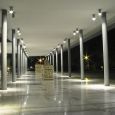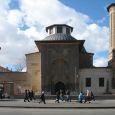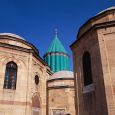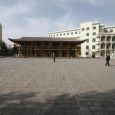Konya
Advertisement
By Plane
Turkish Airlines has flights each day but not so frequent between Istanbul and Konya.
By Train
The Meram Ekspresi (Meram Express) is the comfortable daily all sleeping car train between Istanbul (Haydarpasa) and Konya.The Toros Ekspresi (Taurus Express) is the three-days-a-week alternative, hauling one sleeping car, two couchette cars, and Pullman and seating compartment cars between Istanbul (Haydarpasa) and Konya.
There is also the Iç Anadolu Mavi Tren (Inner Anatolia Blue Train), which is a night train between Istanbul (Haydarpasa) and Konya
By Bus
Several companies run buses to Konya from many other Turkish cities, including Aksaray, Ankara, Antalya, Isparta , Egirdir, Istanbul and Nevsehir (Cappadocia). Here are estimated travel times.
For example, five companies run buses on the 663km (412mi), 10-hour trip between Istanbul and Konya. There are even more frequent buses between Ankara and Konya (260 km/162 miles, 3.5 hours). (More distances and travel times below.)
Advertisement
Archeological Museum
South of the Sirçali Medrese at the edge of the old town of Konya stands the Archeological Museum which houses a comprehensive display of architectural exhibits, stelae, statuettes from the various eras, but mainly fantastically decorated Roman sarcophagi.
Ince Minare
Between 1260 and 1265 the Vizier Sahip Ata endowed the Ince Minare in Konya, which was designed by Keluk Ibn Abdullah. The once-slim minaret finished with enamel tiles and bricks was struck by lightning in 1901. The richly sculpted Baroque decorations on the side of the portal are of special interest. The Koran school is now a museum housing selected wooden and stone sculptures including animal reliefs from the old city walls.
Mevlana Tekkesi
In the east of the old town of Konya stands the famous green conical roof which covers the tomb of the philosopher and theologist Mevlana Celaleddin. The roof has become a symbol of the town and the mausoleum is visited not only by tourists but also by countless Turkish pilgrims, who come to pay their respects to one of the country's greatest mystics. Anatolian villagers come in their thousands to pray at the tomb of the man Mevlana Celaleddin who was for many more than a philosopher and saint. His words are not just engraved on his own mausoleum but also on the tombstones of believers: "Do not seek our tombs on this earth - our tombs are in the hearts of the enlightened".
The monastery, whose present layout dates from the 16th century, is entered through a gate and an impressive garden of fountains, trees and tombstones. Inside can be found not just Mevlana's sarcophagus, but that of his wife Kerra Hatun, his children Melike Hatun and Müzafferüddin Emir Ali Çelebi, plus the tombs of six dervishes, the so-called "Soldiers of Horasan", who came to Konya from Balkh with Mevlana. In addition the large complex houses a huge collection of artifacts belonging to the Mevlana Order, valuable carpets, metal and wooden objets d'art, musical instruments and books, most of which can be found in the former dance-hall, the monk's cells and the mosque. The grounds of the complex contain a bright blue marble fountain (1512) and more mausoleums. The museum itself has an ethnography section and also a library with over 1,700 manuscripts and 500 books.
Tower Mosque
To the southwest behind the bazaar in the Odun Pazari quarter stood one of Konya's old gates and the Ihyaiyye Camii or Kapi Camii (Tower Mosque) is named after it. The building was constructed in 1658, it fell into disrepair and in 1811 Konya's Mufti (spiritual leader) Esenlerlizade Seyid Abdurrahman commissioned a new mosque. A fire destroyed the mosque and adjoining shops but it was rebuilt the following year. The roof of the eight-domed mosque, one of the oldest Ottoman mosques in Konya, is supported by ten pillars.
April - October
July - August -> 30(°C) - Summer
January - February -> 0(°C) - Spring
Advertisement







